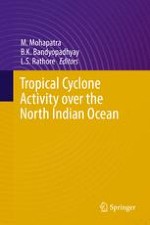2017 | OriginalPaper | Chapter
Governing Factors Associated with Intensification of TC-A Diagnostic Study of VSCS PHAILIN and LEHAR
Authors : G. K. Das, G. C. Debnath
Published in: Tropical Cyclone Activity over the North Indian Ocean
Publisher: Springer International Publishing
Activate our intelligent search to find suitable subject content or patents.
Select sections of text to find matching patents with Artificial Intelligence. powered by
Select sections of text to find additional relevant content using AI-assisted search. powered by
